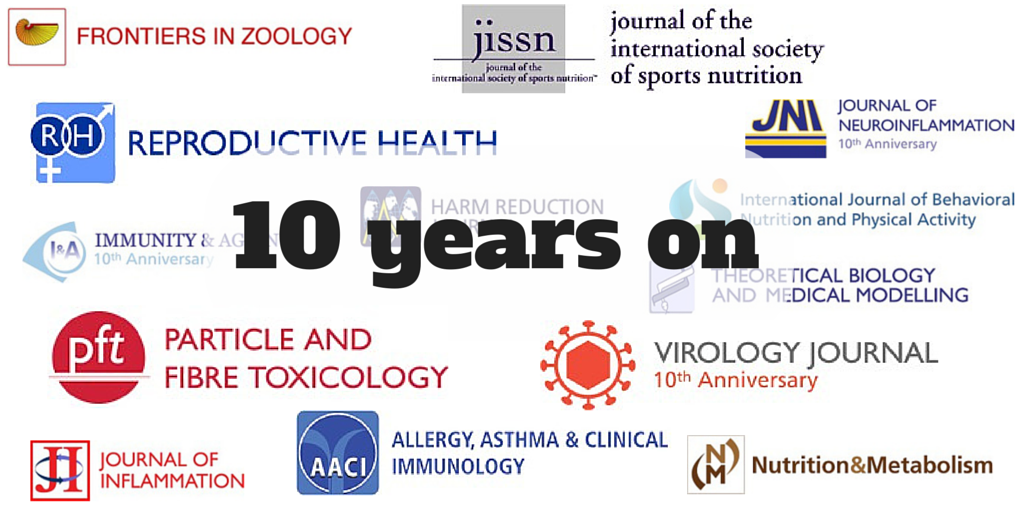We have a whole host of journals celebrating their 10th anniversaries this year. To mark such a special occasion, and as part of Open Access Week, we asked some of our Editors-in-Chief to give us their perspectives on the last 10 years, and how their journal – and open access publishing – has changed. Here’s the first of two posts with their thoughts…

In the 10 years since your journal started, what changes have you seen to publishing, and researchers’ attitudes to open access?
José M. Belizán, Reproductive Health: I can see that researchers are becoming keener to publish in open access journals since they value the speed of the process, the fact that these journals do not have the limitation of space or on number of articles published, and mostly that they can be read by everybody in every country.
Linfa Wang, Virology Journal: In 2004 the publishing landscape was very different. BioMed Central had launched only a few years earlier and there were very few open access journals in any subject area. Virology Journal was probably the first open access journal in its field. Now of course there are plenty of open access journals in virology and the old subscription journals also allow individual articles to be open access, so this has been a huge change. We’ve seen Virology Journal grow incredibly fast in its first few years, from just 15 publications in 2004, to over 100 two years later, to more than 500 in 2011. This really shows how popular Virology Journal, and open access, have become in the last ten years.
Flemming Cassee, Particle and Fibre Toxicology: When we started there was a lot of scientism toward open access (“where is the printer version, where is the volume/issue?”) but this has now turned into a general belief that open access is a very good way to publish scientific research, provided that the peer review process and the editorial board can act independently from the publisher regarding acceptance of the number of manuscripts for publication per year. We also see that funding agents such as EU DG Research & Innovation actually request to publish in open access journals to make sure that the science is accessible to everybody and it does not depend on subscriptions.
Jose Antonio, Journal of the International Society of Sports Nutrition: Researchers love the speed in which papers are reviewed and published. With the abundance (perhaps the market is saturated) of peer-reviewed science journals, it no longer is ‘necessary’ to publish in the so-called ‘top tier’ journals. You can get plenty of exposure and ‘impact’ in a lower tier open access journal. My personal opinion is that the ‘impact factor’ is an antiquated way of measuring the ‘success’ of a journal. For most journals, it really is only a few key papers (particularly review papers) that are widely read.
Richard Warrington, Allergy, Asthma & Clinical Immunology: The most striking change that we have seen in the last 10 years is the tremendous increase in Open Access Journals and their acceptance by so many researchers.
What do you think has been the journal’s biggest achievement in the last 10 years (other than Impact Factor)?
José M. Belizán: In my opinion the biggest achievement has been the increasing number of articles received from researchers in low-and middle-income countries.
Linfa Wang: The biggest achievement for Virology Journal is to be considered as one of the mainstream journals that virologists would consider for publication of their results. We are also proud to have one of the fastest reviewing processes in place for journals in this discipline. Both of these achievements, rapid recognition and fast turnaround time, are greatly helped by the open access nature of the journal.
Flemming Cassee: Specifically for Particle and Fibre Toxicology, I think that we have published high impact papers and contributed to the notion that particle and fibre toxicology as a subject is a very special from of toxicology
Jose Antonio: JISSN’s biggest impact is in legitimizing the field of sports nutrition science. Twenty years ago, sports nutrition is was NOT considered a viable field of scientific inquiry. Today it is the fastest growing segment of the Exercise and Sports Science category.
Richard Warrington: The Journal’s biggest achievement in the last 10 years (other than being tracked for an Impact Factor and indexing) is our ability to attract increasing numbers of submissions internationally. Previously, as a new journal that was not open access, we relied upon submissions by invitation, which limited the number of manuscripts that we could publish yearly.
You can read an Editorial by Richard Warrington and Paul Keith about AACI’s 10th anniversary on the journal’s website.
Comments